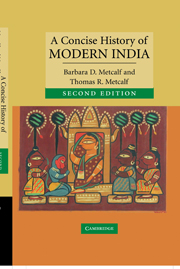Book contents
- Frontmatter
- Contents
- List of illustrations
- Preface to the second edition
- Preface to the first edition
- Glossary
- Chronology
- 1 Sultans, Mughals, and pre-colonial Indian society
- 2 Mughal twilight: the emergence of regional states and the East India Company
- 3 The East India Company Raj, 1772–1850
- 4 Revolt, the modern state, and colonized subjects, 1848–1885
- 5 Civil society, colonial constraints, 1885–1919
- 6 The crisis of the colonial order, 1919–1939
- 7 The 1940s: triumph and tragedy
- 8 Congress Raj: democracy and development, 1950–1989
- 9 Democratic India in the nineties: coalitions, class, community, consumers, and conflict
- Epilogue: a new century begins
- Biographical notes
- Bibliographic essay
- Index
- CAMBRIDGE CONCISE HISTORIES
8 - Congress Raj: democracy and development, 1950–1989
Published online by Cambridge University Press: 05 June 2012
- Frontmatter
- Contents
- List of illustrations
- Preface to the second edition
- Preface to the first edition
- Glossary
- Chronology
- 1 Sultans, Mughals, and pre-colonial Indian society
- 2 Mughal twilight: the emergence of regional states and the East India Company
- 3 The East India Company Raj, 1772–1850
- 4 Revolt, the modern state, and colonized subjects, 1848–1885
- 5 Civil society, colonial constraints, 1885–1919
- 6 The crisis of the colonial order, 1919–1939
- 7 The 1940s: triumph and tragedy
- 8 Congress Raj: democracy and development, 1950–1989
- 9 Democratic India in the nineties: coalitions, class, community, consumers, and conflict
- Epilogue: a new century begins
- Biographical notes
- Bibliographic essay
- Index
- CAMBRIDGE CONCISE HISTORIES
Summary
Hammered out during intense debates in a constituent assembly which sat from 1947 to 1949, India's constitution established a set of principles and institutions that have governed the country's political life up to the present. Under it, as Nehru sought to create a ‘modern’ free India, the country decisively repudiated much of its colonial heritage. Although remaining a member of the Commonwealth, India was proclaimed a republic, thus ending its allegiance to the British Crown, when the constitution was inaugurated. That date, 26 January, known as Republic Day, with a massive parade in New Delhi, has remained a major focus for India's celebration of its nationhood. Rejecting the imperial vice-regal style of government associated with the Raj, the new India nevertheless sought inspiration in domestic British political practice. The constitution put in place a Westminster style of government, with a parliament comprising two houses, and a prime minister selected by the majority party in the lower house, called the Lok Sabha or House of the People. Nehru took up the position of prime minister, while the president, installed in the old vice-regal palace, acted, like the sovereign in Britain, as titular head of state. The old colonial separate electorates, with their divisive tendencies, were in similar fashion abolished in favour of single member constituencies, modelled on those in Britain itself, open to all.
- Type
- Chapter
- Information
- A Concise History of Modern India , pp. 231 - 264Publisher: Cambridge University PressPrint publication year: 2006

